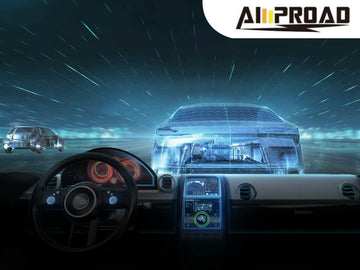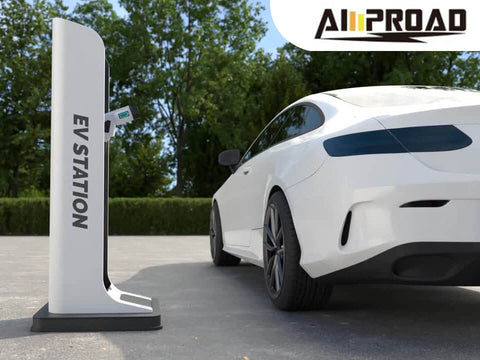
Ever wonder how electricity magically flows from a charging station to your electric car? The secret isn't the cable itself, but what it's connected to! Unlike the charger, which acts like a translator converting grid power, the EV charging cable is a simple but vital bridge. It transmits the already converted electricity, ensuring a smooth flow of power to charge your car's battery. Keep reading to learn exactly how these cables work and how to choose the right one for your electric vehicle!
What is an EV charging cable, and how is it different from an EV charger?
An EV charging cable and an EV charger are two essential components of the electric vehicle (EV) charging system, each with distinct functions.
The EV charging cable serves as the physical connection between the charging infrastructure and your EV. It acts as a conduit, transmitting the prepared electricity from the EV charger to your vehicle's charging port. Think of it as a bridge, facilitating the flow of power without altering its properties. Unlike the EV charger, the cable does not convert or regulate electricity; its sole purpose is to establish a direct link between the charger and your EV.
On the other hand, the EV charger is the electronic device responsible for managing the flow of electricity for charging your EV battery. It acts as both a converter and a regulator, transforming grid power into a suitable form for charging the EV battery and controlling the flow of electricity to ensure safe and efficient charging. Essentially, while the charging cable facilitates the physical transfer of electricity, the charger controls and regulates the entire charging process to provide a reliable power supply for your EV.
In a nutshell, the EV charging cable serves as the conduit for transmitting electricity, while the EV charger manages and regulates the flow of electricity for safe and efficient charging. Together, these components form a cohesive system that enables you to charge your EV conveniently and reliably, whether at home, at a public charging station, or on the road.
What is the role of an EV charging cable in the charging process?
The EV charging cable plays a crucial role in the electric vehicle (EV) charging process, serving as the physical link between the charging infrastructure and the EV itself. Its primary function is to transmit the prepared electricity from the EV charger to the vehicle's charging port, facilitating the flow of power necessary to charge the EV battery.
Think of the EV charging cable as a bridge that connects the charger to the EV, enabling the transfer of electricity without altering its properties. It acts as a conduit, allowing the power generated by the charger to reach the EV's battery safely and efficiently.
Unlike the EV charger, which converts and regulates electricity, the charging cable is a passive component that simply carries the electricity from one point to another. It does not modify the electrical current but instead ensures that the power generated by the charger is delivered to the EV without interruption.
The EV charging cable comes in various lengths and configurations to accommodate different charging scenarios, whether at home, at a public charging station, for example Tesla destination charger, or on the road. It is typically equipped with connectors at both ends—one end plugs into the charger, while the other end connects to the EV's charging port.
Overall, the EV charging cable plays a vital role in facilitating the charging process, enabling EV owners to conveniently and safely charge their vehicles whenever and wherever they need to. Without this essential component, the transfer of electricity from the charger to the EV would not be possible, highlighting the importance of the charging cable in supporting the widespread adoption of electric vehicles.
Function of the EV Charging Cable

Does the EV charging cable convert electricity?
Unlike the EV charger, the EV charging cable does not convert electricity. Its role is solely to transmit the prepared electricity from the charger to the vehicle's charging port without altering its properties. While the charger converts grid power into a suitable form for charging the EV battery and regulates the flow of electricity, the charging cable acts as a passive conduit, ensuring that the power generated by the charger reaches the EV's battery without any modifications.
How does the cable transmit electricity?
Imagine the EV charging cable as a bridge, connecting the EV charger to the vehicle's charging port. Just as a bridge facilitates the passage of vehicles from one side of a river to another without changing their characteristics, the charging cable enables the flow of electricity from the charger to the EV without altering its properties. It serves as a seamless conduit, allowing the prepared electricity to travel from the charger to the EV's battery safely and efficiently.
Are there different types of EV charging cables?
Yes, there are different types of EV charging cables, each designed for specific charging scenarios and compatibility with different EV models. The most common types of EV charging cables include:
- Level 1 Charging Cables: These cables are typically included with the purchase of an EV and are used for standard home charging. They plug into a standard household outlet and provide a slow charging rate, making them suitable for overnight charging.
- Level 2 Charging Cables: Level 2 EV charger cables offer faster charging speeds compared to Level 1 cables. They require a dedicated charging station with a higher power output and are commonly found at public charging stations, workplaces, and residential charging installations.
- DC Fast Charging Cables: DC fast charging cables are designed for rapid charging at public fast charging stations. They deliver high-power DC electricity directly to the EV's battery, significantly reducing charging times compared to Level 1 and Level 2 charging. These cables are compatible with EVs equipped with fast charging capabilities and are ideal for long-distance travel or quick top-ups on the go.
Are there different types of EV charging cables with varying connector types depending on the charging standard?
Yes, EV charging cables come with different connector types to accommodate various charging standards and protocols. Some of the most common connector types include:
- J1772 (SAE J1772): This connector type is widely used in North America and is the standard connector for Level 1 and Level 2 charging. It features a distinctive "J" shaped plug with five pins and is compatible with most electric vehicles on the market.
- CCS Combo (Combined Charging System): The CCS connector combines the traditional J1772 connector for AC charging with two additional DC pins for rapid DC charging. It is commonly used in Europe and is becoming increasingly popular in other regions as well. The CCS connector enables EVs to charge using both AC and DC power, providing flexibility and interoperability across different charging networks.
- CHAdeMO: While not mentioned in the original question, CHAdeMO is another connector type commonly used for DC fast charging, particularly in Japan and some other regions. It features a large, round plug with multiple pins and is compatible with certain EV models, primarily those from Japanese manufacturers.
- NACS (Tesla): Tesla uses a proprietary connector called NACS for its Supercharger network. While Tesla has recently opened up its charging network to other EVs with adapters, NACS cables are primarily used by Tesla owners for optimal charging at Tesla Superchargers.
Each connector type corresponds to a specific charging standard and protocol, with compatibility varying depending on the region and the EV manufacturer. When selecting an EV charging cable, it's essential to ensure that the connector type matches the charging standard supported by your vehicle and the charging infrastructure to ensure seamless and efficient charging.
How to Choosing the Right Cable?
Now that we understand the vital roles of EV chargers and cables, let's explore how to choose the perfect cable for your electric vehicle (EV). Here are
2 key factors to consider
- Compatibility with your EV: It's like having the right key for the right lock. Check your car's owner's manual or manufacturer's website to identify the compatible connector type for your specific EV model. Most EVs in North America will likely use the J1772 connector for home charging and Level 2 public charging stations.
- Compatibility with the charging station: Not all stations are created equal! Before plugging in, look for the designated connector type at the charging station. Most stations will have labels or icons indicating whether they use J1772, CCS Combo, or NACS (Tesla). Mismatched connectors simply won't connect, so double-checking ensures a smooth charging experience.
Bonus Tip: Cable Length and Additional Features
While not essential, some additional factors can influence your cable choice. Consider the length of the cable - a longer cord offers more flexibility when parking at home or public stations. Some cables might also include features like built-in current meters to monitor charging speed or temperature sensors for added safety.
Remember, for the fastest home EV charging experience, you'll typically need a Level 2 charger installed at your home, which can be paired with a J1772 connector cable, like the AMPROAD Level 2 Portable J1772 Charger. This charger offers a convenient solution for those who want the flexibility of a portable charger without sacrificing power.
By understanding these factors and choosing the right cable, you can ensure a safe, efficient, and convenient charging experience for your EV, keeping you on the road with minimal downtime.




